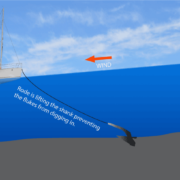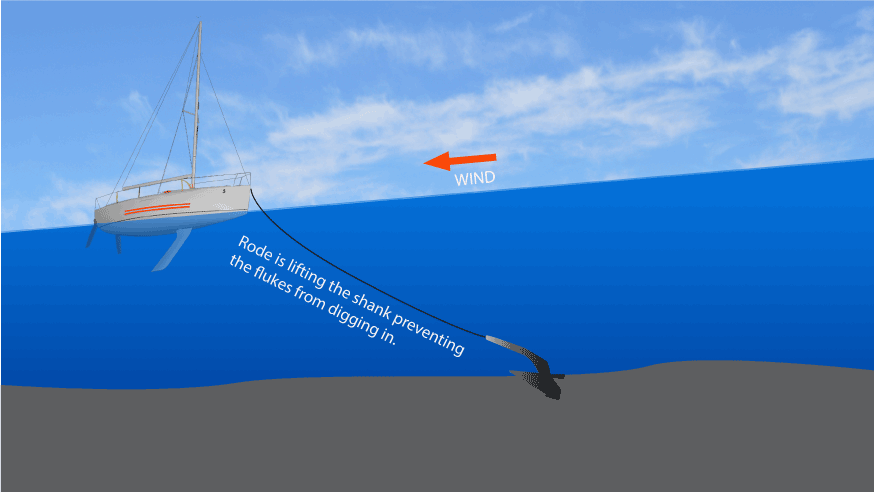Anchoring Rode and Scope
Rode
To hold a sailboat, the anchor must naturally be attached to the vessel. This is accomplished by using “rode,” which is either all chain or a combination of rope (nylon line) and chain. Rode, then, is the stuff in the middle between the anchor itself and the boat. In this discussion, the words rope and line are interchanged. Some people say “anchor rope” and “anchor line” when they mean the rope part of the rode. Then there are the people who say there are no ropes on a boat. But from the rigging discussion earlier, we know is wrong.
Nylon line for the rope part is good because of its elasticity and light weight and low comparative cost. Chain is good because of its strength, weight, and ability to withstand abrasion. Chain weight is both good and bad. Good because it helps hold the anchor to the bottom, and bad because it adds significant weight to the bow of the boat when stored in the anchor locker.
A typical combination chain and line anchor rode is made up of one boat length of chain and 250 to 300 feet (80m to 100m) of nylon line.
Larger boats use all chain for their anchor rode. This increases their ability to stay tightly connected to the bottom while letting out less rode. The larger boat’s buoyancy can make up for the extra weight of the chain.
The “bitter end” is the opposite end of the rode from the anchor. Typically it is connected to the boat.
The path (curve) of the anchor rode from the bow to the anchor is mathematically a “catenary,” created by gravity pulling down on the rode. Since a chain is much heavier than a rope/line, the catenary shape is much different for a chain than a rope/line, as you can imagine. A chain tends to sit on the bottom for as much of its length as possible and because of this:
- The anchor is held flat, which gives it a better holding ability
- The curve is much greater; therefore, when the boat is hit by a wave the shock is taken up by the rising of the chain and does not stretch in the rope/line
- Abrasion on sharp rocks on the bottom is not an issue
- It is heavy and also difficult to pull up without some sort of mechanical advantage such as a windlass
Scope
“Scope” is the ratio of the length of the rode compared to the depth of the water the anchor is set in.
Amount of Rode to Let Out
Left Behind – AdriftIn the bay off Komiza Village on the Island of Viz, Croatia, 3 boats in our flotilla anchored for the night – rafted up together. In the morning, our boat got up early and cast off lines from the others, and snuck into town for pastries and coffee. A few hours later the crew from the other boats came complaining down the cobblestone street to me exclaiming that they had drifted out to sea. They claimed that we cast them adrift because their anchors did not hold. This is a classic case of when pointing a finger at someone – three fingers are pointing back at yourself. Apparently, our anchor was the only anchor that held the entire flotilla in place during the night. (1) make sure you know how to anchor (2) make sure others know how to anchor. |
It is vital you understand the necessity of letting out sufficient rode. You cannot simply dangle your anchor on the bottom or toss a heap over and hope for the best.
- For all chain, the length you let out should be 50 ft (15 m) plus 2 times the depth.
- For a combination of rope and chain, the length you should let out should be 50 ft (15 m) plus 4 times the depth.
Note that you must allow for tidal change. Check the local tides to find the deepest depth and base your rode length calculations on the deepest depth of the tide throughout the night.
Also, allow for the safety depth on the depth sounder if reading depth from the depth sounder. For example, many boats set a 10 ft (3m) safety depth to account for the 5 ft (1.5 m) keel depth plus an extra 5 ft (1.5 m) of safety. In this case, if the depth meter reads 20 feet (7 m) at high tide, the real depth might be 30 feet (10m). Some people even account for the height difference from the water to the bow as technically this adds to the vertical distance to the bottom.
In this example of a 30 ft (9 m) depth the amount of rode to let out is:
- All chain 50 ft plus 60 ft = 110 ft — 15 m plus 18 m = 33 m
- Rope and Chain 50 ft plus 120 ft = 170 ft — 15 m plus 36 m = 51 m
You can quickly see that a 30 ft (9m) depth leads to a lot of rode needing to be let out if using rope and chain combination.
As an additional example (you’ve got to get good at this), let’s say it is half tide and the tide range is 10ft (3m) and the depth meter reads 20 ft (6 m), what should you let out?
- Consider the depth to be 20 ft (depth meter) + 10 ft (keel + safety) + 5 ft(more tide rise) = 35 ft (10.5 m)
- All chain 50 ft plus 70 ft = 120 ft — 15 m plus 21 m = 36 m
- Rope and Chain 50 ft plus 140 ft = 190 ft — 15 m plus 42 m = 57 m
Just as an aside, you get a weird sense of lengths when anchoring. Consider this: if your boat is 40 feet long, 80 feet is only 2 boat lengths. To gain experience and confidence with this concept, consider snorkeling the anchor after you have laid it.
The simple formula above ensures ample rode is let out at shallow depths while not too much at deeper depths.
Some people have a hard and fast rule of 7 times the depth, but this tends to let out too little at shallow depths and way too much at deeper depths.
You will always have some balancing decisions to make around how much to let out. Some factors to consider in your decision include:
- The harbor is crowded
- Some boats may be using all chain (and thus less swing) while others use chain and rope (more swing)
- Your own swing
- Predicted night wind shifts and strengths
- Tidal change
- The amount of chain before rope on your rode
- The closeness to shore or underwater rocks
Because of all these factors, it is best that you set a GPS anchor alarm and a depth change alarm to warn you if you have moved and multiple time alarms just to get up multiple times in the night to check.
NauticEd has a free anchor alarm built into its iOS TrackLink app. You can also download the Anchor Zone App on Google Play or iOS. Both are excellent anchor alarm apps.
A full blog article on the mathematics of anchor rode length is here.
Below is an example of too little rode being let out. You can pretty much guarantee that your boat will “drag its anchor” at this scope.
Scope Too Short
Sufficient Scope
Play the below animation to see how a proper amount of rode keeps the rode lying horizontal in a wind gust.
Anchoring Animation
Finally, you need a way to determine how much anchor line has been “paid out.” A good suggestion is to mark the chain and/or nylon line at every 25 feet (7m). Chandleries carry a variety of markers for this purpose. Paint of different colors on the chain is good and many people use nylon tie wraps: 1 at 25 feet, 2 at 50 feet, and 3 tie wraps at 75 feet.
Here’s a fun video where we dive the anchor and check its set as well as a few other things we found on the bottom.
Dive the Anchor Video
Notes
- If you plan on staying awake and aware while anchoring for a short time, and the wind is light, you might be able to lessen your scope.
- Be aware that anchoring at deeper depths (>30 ft (9m)) can create a large diameter circle for your boat to swing around, which is sometimes not desirable.
- In general, try to anchor shallower keeping in mind the tide, swing, and obstacles.
- In general, the more rode you let out, the better the holding power of the anchor.
Anchor and Rode Inspection
Since your boat and life depend on your anchor’s ability to hold your boat off the rocks, it’s a good idea to ensure that the rode will not let you down.
At least every six months:
- Inspect the rode length for rust and abrasion.
- Inspect the connections from rope to chain and chain to anchor.
- Ensure that the pin in the D-ring connecting the chain to the anchor is secured tightly with stainless steel wire so it cannot work free.
- Inspect the cleat that holds the rode to the boat to ensure it is solidly mounted.
- Ensure that the end of the anchor line, called the “bitter end,” is firmly attached to the vessel, usually to a special cleat located in or near the anchor locker.
- Inspect the mounting of the windlass (if fitted).








